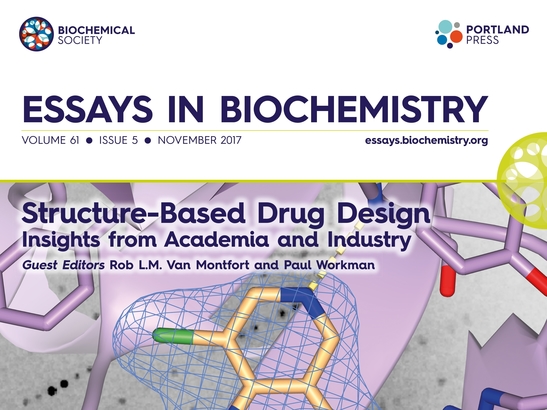
Essays in Biochemistry publishes reviews from experts in biochemistry, and is written to be accessible to people who are new to the field, as well as being of interest to experts.
Out today is a special edition of the journal focusing on the field of structure-based drug design, which uses information about the three-dimensional structure of proteins within cells in the design of new medicines.
It features 10 articles from specialists in the field, selected by its guest editors Professor Paul Workman, Chief Executive and President, and Dr Rob van Montfort, a Team Leader here at The Institute of Cancer Research.
The guest issue is introduced by a commentary jointly penned by Dr van Montfort and Professor Paul Workman.
Read Professor Paul Workman' Drug Discoverer blog, where he writes and talks extensively about challenges facing the cancer drug ecosystem.
Advances in structure-based drug design
Their editorial provides a brief overview of the advances made in structure-based drug design, from its roots in the protein crystallography of the 1950s and 1960s, via its utilisation in fragment-based approaches developed in the late 1990s, through to the potential drug discovery application of cryo-electron microscopy (cryo-EM) – a technique for which three of its pioneers won this year’s Nobel Prize in Chemistry.
The editorial emphasises how structure-based design has become central to discovery of new medicines – aiding medicinal chemists to aim for a ‘perfect fit’ between the drug and the target protein. Also highlighted is the important impact of novel technologies in empowering new biological insights as well as innovative design opportunities.
It also highlights the use of structure-based approaches in the design of high quality chemical probes that can be used with confidence to explore mechanistic biology in healthy and diseased cells.
We take a quick look at each of the articles in the issue:
1. Structure-based discovery and development of cyclin-dependent protein kinase inhibitors
This paper, from Professor Martin Noble and colleagues from the Newcastle Cancer Centre, reviews the structural data on cyclin dependent kinase (CDK) inhibitors that illustrates how they work, and how they are selective for specific members of the CDK family.
2. Current perspectives in fragment based lead discovery (FBLD)
This review, written by Professor Roderick Hubbard and Bas Lamoree of the University of York, is an overview of current practice and new developments in the field of fragment-based lead discovery (FBLD) – a technique for finding very small-molecules that bind to a drug target and can be used as starting point to design larger more potent drug molecules.
3. Mass spectrometry for fragment screening
This paper, from Professor Chris Abell and his team at the University of Cambridge, reviews recent examples of the use of mass spectrometry in fragment screening.
Until recently, they argue, mass spectrometry was an under-used tool in structure-based drug discovery, in comparison to techniques such as nuclear magnetic resonance.
4. Fragment‐based drug discovery and its application to challenging drug targets
In this paper, Dr Benjamin Cons and colleagues at Astex Pharmaceuticals look at fragment-based drug design applied to targets that are challenging to drug.
The researchers illustrate the benefits of the technique with a recently published case study of a drug discovery programme aimed at a challenging target – the KEAP1/NRF2 protein-protein interaction.
5. NMR in structure-based drug design
This paper sees Dr Gregg Siegal, Chief Executive of the Leiden-based company ZoBio, and his colleagues, discuss the strengths and limitations of NMR in structure-based drug discovery, particularly focusing on the different resolution levels that the technique can offer, and the throughput that it can achieve.
6. The SGC beyond Structural Genomics: redefining the role of 3D structures by coupling genomic stratification with fragment-based discovery
The Structural Genomics Consortium is a not-for-profit organisation that elucidates the three-dimensional structures of proteins of medical relevance, and makes them freely available.
This paper outlines their plans for the coming years, to help the field of structure-based drug design keep pace with the explosion in genomics data during the last decade.
7. Protein degradation: a validated therapeutic strategy with exciting prospects
8. Molecular recognition of ternary complexes: a new dimension in the structure-guided design of chemical degraders
These papers, from Dr Tom Heightman and Dr Honorine Lebraud of Astex Pharmaceuticals, and Professor Alessio Ciulli and Dr Scott Hughes from the University of Dundee, look at the developing field of proteolysis-targeting chimeras – an exciting approach that works by causing proteins to break down – and current strategies for developing them that are enabled by structure-based design.
9. X-ray Free Electron Laser: opportunities for drug discovery
This paper by Dr Michael Hennig, Chief Executive of leadXpro, and his colleagues looks at the future of X-ray crystallography – specifically, the development of X-ray free electron lasers, which produce very short, but powerful X-ray pulses allowing collection of X-ray data for drug targets for which only very small crystals can be obtained.
The technique also allows data collection at more relevant temperatures, which may give insight in the movements within a drug target that can impact on the binding of a drug molecule.
10. The potential of cryo-electron microscopy for structure-based drug design
In this paper, Professor David Barford and his team from the University of Cambridge argue that cryo-EM is poised to transform the field of structure-based drug discovery, having already revolutionised structural biology by expanding the range of proteins and protein complexes whose structures can be determined at high resolution.
Note: All articles in this issue will be free to read to the end of 2017 thanks to sponsorship from Astex Pharmaceuticals.